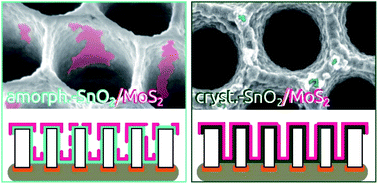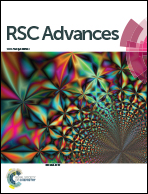Stabilizing an ultrathin MoS2 layer during electrocatalytic hydrogen evolution with a crystalline SnO2 underlayer†
Abstract
Amorphous MoS2 has been investigated abundantly as a catalyst for hydrogen evolution. Not only its performance but also its chemical stability in acidic conditions have been reported widely. However, its adhesion has not been studied systematically in the electrochemical context. The use of MoS2 as a lubricant is not auspicious for this purpose. In this work, we start with a macroporous anodic alumina template as a model support, add an underlayer of SnO2 to provide electrical conduction and adhesion, then provide the catalytically active, amorphous MoS2 material by atomic layer deposition (ALD). The composition, morphology, and crystalline or amorphous character of all layers are confirmed by spectroscopic ellipsometry, X-ray photoelectron spectroscopy, grazing incidence X-ray diffractometry, scanning electron microscopy and energy dispersive X-ray spectroscopy. The electrocatalytic water reduction performance of the macroporous AAO/SnO2/MoS2 electrodes, quantified by voltammetry, steady-state chronoamperometry and electrochemical impedance spectroscopy, is improved by annealing the SnO2 layer prior to MoS2 deposition. Varying the geometric parameters of the electrode composite yields an optimized performance of 10 mA cm−2 at 0.22 V overpotential, with a catalyst loading of 0.16 mg cm−2. The electrode's stability is contingent on SnO2 crystallinity. Amorphous SnO2 allows for a gradual dewetting of the originally continuous MoS2 layer over wide areas. In stark contrast to this, crystalline SnO2 maintains the continuity of MoS2 until at least 0.3 V overpotential.



 Please wait while we load your content...
Please wait while we load your content...